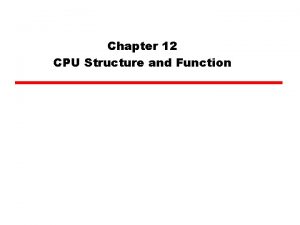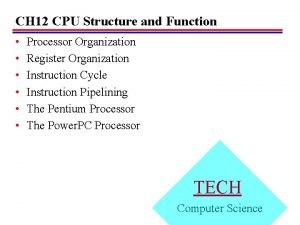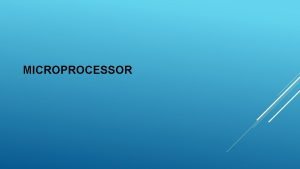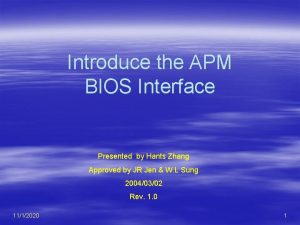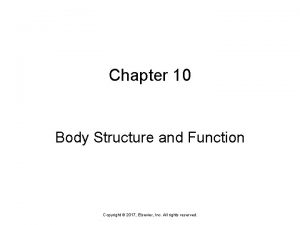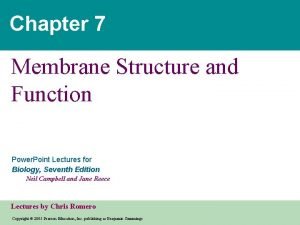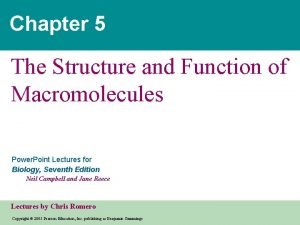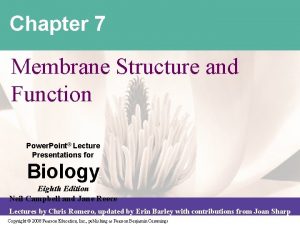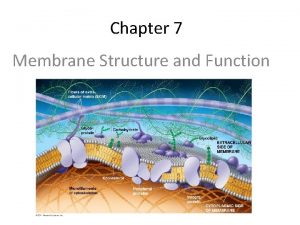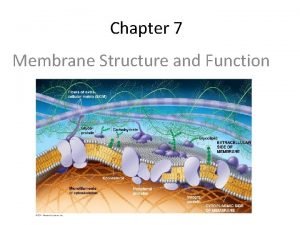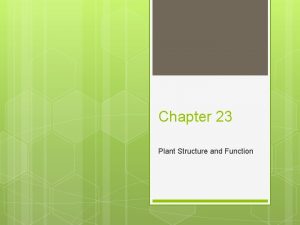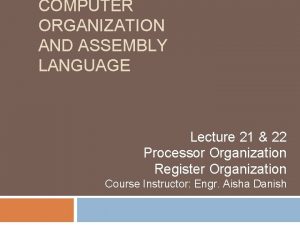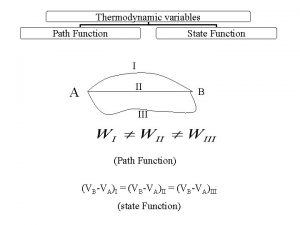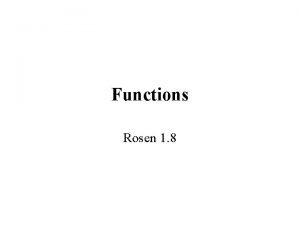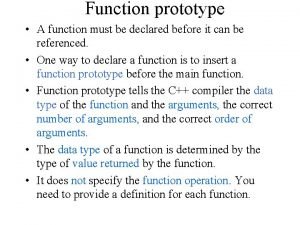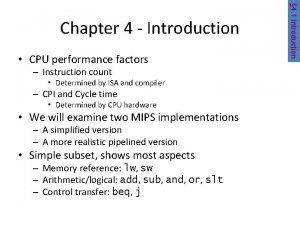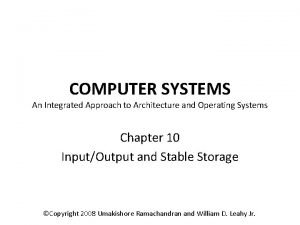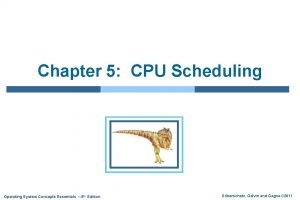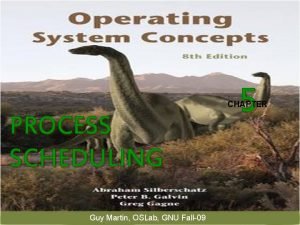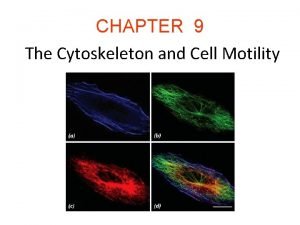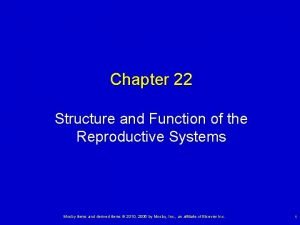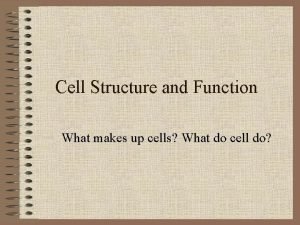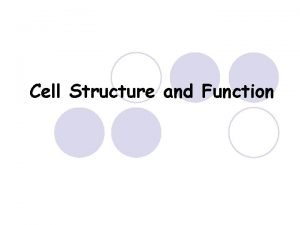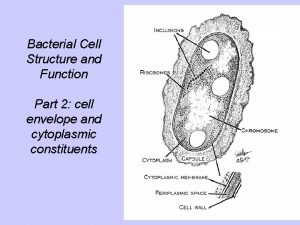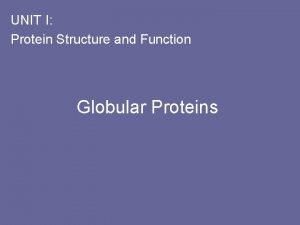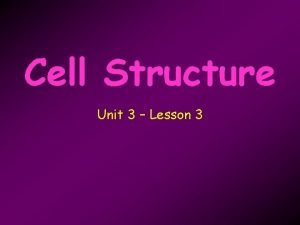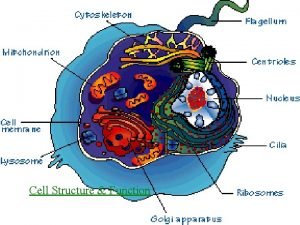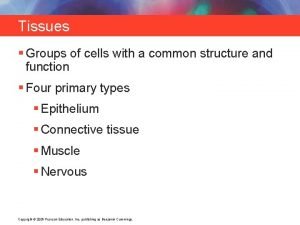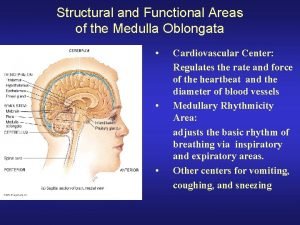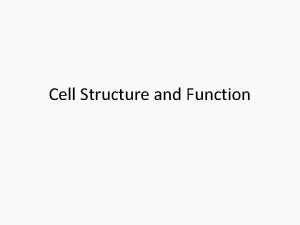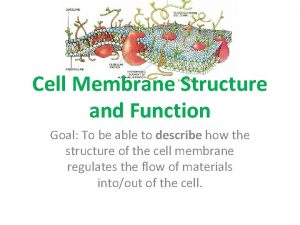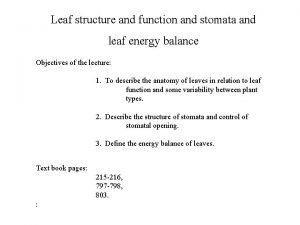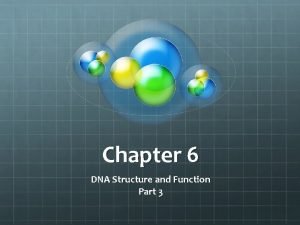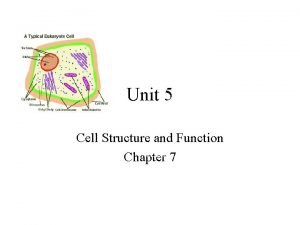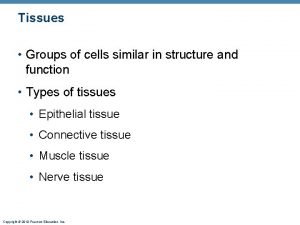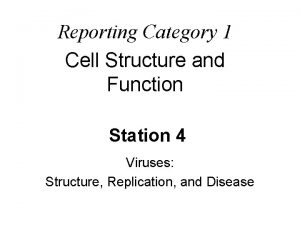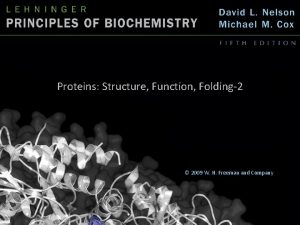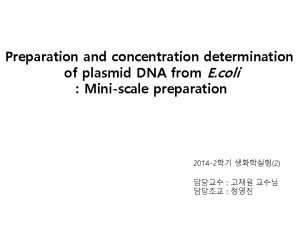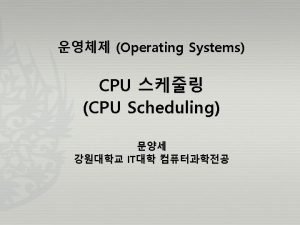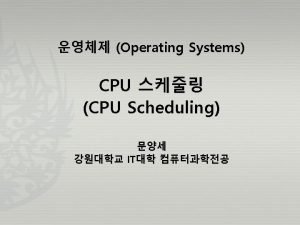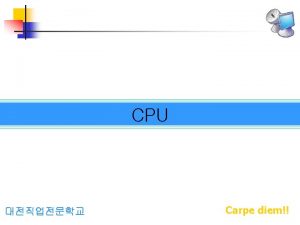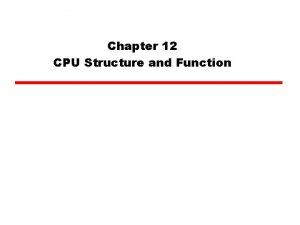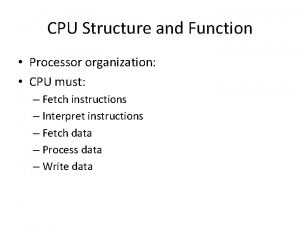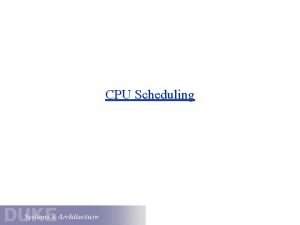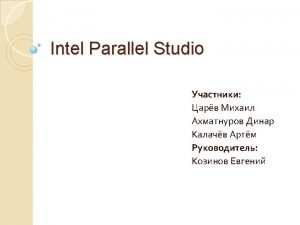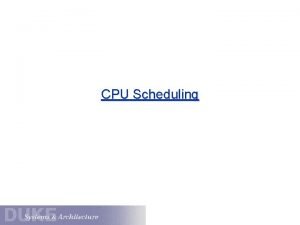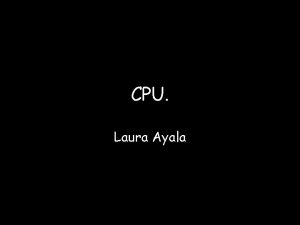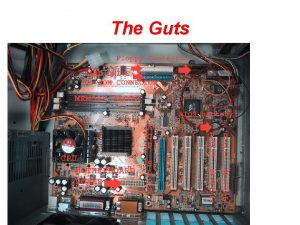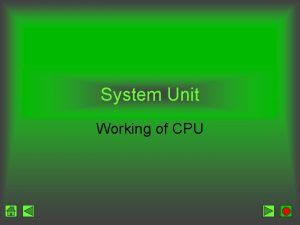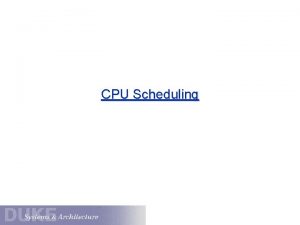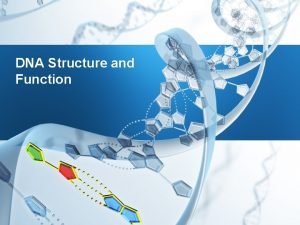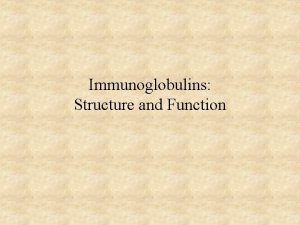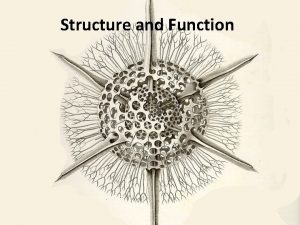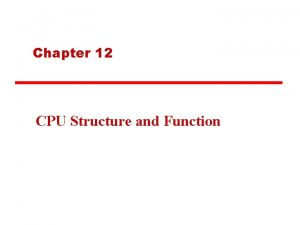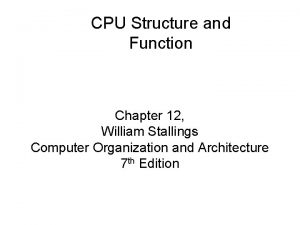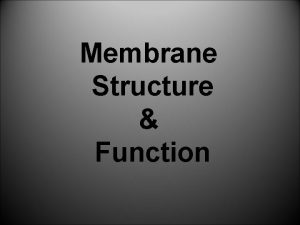Chapter 12 CPU Structure and Function CPU Structure










































































- Slides: 74

Chapter 12 CPU Structure and Function

CPU Structure • CPU must: —Fetch instructions —Interpret instructions —Fetch data —Process data —Write data • Major components of CPU —ALU —Control unit —Register 2

CPU With Systems Bus 3

CPU Internal Structure 4

Registers • CPU must have some working space (temporary storage), which called registers • Number and function vary between processor designs • One of the major design decisions • Top level of memory hierarchy —Small set of high speed storage 5

Registers • Two types of registers — User visible registers: • may be referenced by assembly-level instruction — Control and status: • used by control unit to control CPU operations and by OS programs 6

User Visible Registers • • General Purpose Data Address Condition Codes 7

General Purpose Registers (1) • May be used for true general purpose —E. g. , PDP-11: R 0 ~ R 7 • May be used for restricted purpose —E. g. , stack pointer, floating point registers • May be used for data or addressing —Data – Accumulator, Motorola 68000: D 0 ~ D 7 —Addressing – Segment , stack pointer, Motorola 68000: A 0 ~ A 7 8

General Purpose Registers (2) • General purpose vs. Special purpose • Make them general purpose —Increase flexibility and programmer options —Increase instruction size & complexity • Make them specialized —Smaller (faster) instructions —Less flexibility • Which is better? —No final and best answer —Trend toward specialized 9

General Purpose Registers (3) • • How many? Between 8 ~ 32 Fewer then, more memory references Also, more registers do noticeably reduce memory references —However, a new approach, which finds advantage in the use of hundred of registers, is exhibited in some RISC ! 10

General Purpose Registers (4) • • How big ? Large enough to hold full address Large enough to hold full word Often possible to combine two data registers —That is, two registers to hold one long integer • In C programming • long int a; // 64 bits 11

Control & Status Registers • • • Program Counter Instruction Decoding Register Memory Address Register Memory Buffer Register Program Status Word (PSW) 12

Program Status Word • A set of bits • Includes Condition Codes (CCR) —Sign of last result —Zero —Carry —Equal —Overflow • Interrupt enable/disable, interrupt mask • Supervisor 13

Program Status Word - Example • Motorola 68000’s PSW 14

Supervisor Mode • Intel ring zero • Kernel mode • Allows privileged instructions to execute —E. g. , system call • Used by operating system • Not available to user programs 15

Condition Code Registers (CCR) • Sets of individual bits —Set by CPU as the result of operation —e. g. result of last operation was zero, Z bit is to be ‘ 1’ • Can be read (implicitly) by programs —e. g. Jump if zero • Can not (usually) be set by programs —Some instructions can set or clear the condition registers 16

Condition Code Registers (CCR) • Condition Code Register Bits N, Z, V, C —N (negative) bit is set if result of operation in negative (MSB = 1) —Z (zero) bit is set if result of operation is zero (All bits = 0) —V (overflow) bit is set if operation produced an overflow —C (carry) bit is set if operation produced a carry (borrow on subtraction) • in MC 68 HC 11 E 9, CCR is… H: Half carry flag — 8 -bit register contains five condition code indicators (C, V, Z, N and H), two interrupt masking bits, (IRQ and XIRQ) and a stop disable bit (S) — automatically updated by most instructions. 17

Other Registers • May have registers pointing to: —Process control blocks —Interrupt vectors —Page table pointer • CPU design and operating system design are closely linked 18

Example Register Organizations 19

Instruction Cycle • Review 20

Indirect Cycle • May require memory access to fetch operands • Indirect addressing requires more memory accesses • Can be thought of as additional instruction subcycle 21

Instruction Cycle with Indirect 22

Instruction Cycle State Diagram 23

Data Flow (Instruction Fetch) • Depends on CPU design • In general: • Fetch 1. 2. 3. 4. 5. PC contains address of next instruction Address moved to MAR Address placed on address bus Control unit requests memory read Result placed on data bus, copied to MBR, then to IR 6. Meanwhile PC incremented by 1 24

Data Flow (Fetch Diagram) 1 2 3 6 4 5 25

Data Flow (Data Fetch) • IR is examined • If indirect addressing, indirect cycle is performed 1. 2. 3. Right most N bits of MBR transferred to MAR Control unit requests memory read Result (address of operand) moved to MBR Instruction set format op code Instruction set Op code 0 x 11 memory 0 x 11 0 x. FF ‘A’ operand N bits 4. 5. 6. The address of operand moved to MAR again! Control unit request memory read Result (data operand) moved to MBR 26

Data Flow (Indirect Diagram) 1 2 3 27

Data Flow (Execute) • May take many forms • Depends on instruction being executed • May include —Memory read/write —Input/Output —Register transfers —ALU operations 28

Data Flow (Interrupt) • Simple, predictable • Current PC saved to allow resumption after interrupt • Include 1. 2. 3. 4. 5. Contents of PC copied to MBR Special memory location (e. g. stack pointer) loaded to MAR Control unit: WRITE MBR written to memory PC loaded with address of interrupt handling routine (Next instruction (first of interrupt handler) can then be fetched) 29

Data Flow (Interrupt Diagram) 2 5 1 3 4 30

Prefetch • Fetch accessing main memory • Execution usually does not access main memory • Can fetch next instruction during execution of current instruction • Called instruction prefetch 31

Improved Performance • But not doubled: —Fetch usually shorter than execution – Prefetch more than one instruction? —Any jump or branch means that prefetched instructions are not the required instructions • Add more stages to improve performance 32

Pipelining • • • Fetch instruction Decode instruction Calculate operands (i. e. EAs) Fetch operands Execute instructions Write result • Overlap these operations 33

What is Pipelining ? • is a technique to increase their throughput (the number of instructions that can be executed in a unit of time) 34

The Concept of Pipelining • The case of washing clothes Input : dirty clothes Washing, Drying and Folding Output: clean clothes • Tasks —Ann, Brian, Cathy and Dave each have one load of clothes to wash, dry and fold • Washing takes 30 mins • Drying takes 40 mins • Folding takes 20 mins 35 Ref) http: //www. seas. upenn. edu/~palsetia

Case 1: Sequential Laundry • Task order : Ann, Brian, Cathy and Dave • Entire workload takes 6 hours to complete 36

Case 2: Pipelined Laundry • Pipelined laundry takes only 3. 5 hours • Speedup = 6 hours / 3. 5 hours = 1. 7 • Pipelining did not reduce the completion time for one task but it helps the throughput of the entire workload 37

Two Stage Instruction Pipeline 38

Two Stage Instruction Pipeline (more) • To fetch an instruction, accessing main memory is required • Execution usually does not access main memory • So it can fetch next instruction during execution of current instruction • It is called instruction prefetch or fetch overlap • Ideally instruction cycle time would be halved (if duration. F = duration. E …) 39

Two Stage Instruction Pipeline (more) • But in reality, it is not doubled because… • The execution time is longer than the fetch time • The conditional branch instruction makes the address of the next instruction to be fetched unknown 40

Two Stage Instruction Pipeline (more) • Add more stages to improve performance • Reduce time loss due to branching by guessing • If not branched use the prefetched instruction else discard the prefetched instruction fetch new instruction 41

The Six Stage Pipelining • More stages more speedup FI: Fetch instruction DI: Decode instruction CO: Calculate operands (i. e. EAs) FO: Fetch operands EI: Execute instructions WO: Write result • Various stages are of nearly equal duration • Overlap these operations 42

Timing Diagram for Instruction Pipeline Operation = pipeline cycle time k = number of stages : 6 n = number of instructions : 9 • To execute 9 instructions in 6 stage-pipeline device, it takes 14 time units to complete • cf. in the case of no pipeline: 54 time units are required 43

Speedup of Pipelining • Parameters = pipeline cycle time = time to advance a set of instructions one stage k = number of stages n = number of instructions • Time to execute n instructions (In the case of no branch) Tk = [k + (n - 1)] • Time to execute n instructions without pipelining T 1 = nk 44

Speedup of Pipelining • Speedup of k-stage pipelining compared to w/o pipelining 45

Limitation by Branching • Conditional branch instructions can invalidate several instruction prefetches • For example, —Instruction 3 is a conditional branch to instruction 15 —Next instruction’s address won’t be known till instruction 3 is executed (at time unit 7) pipeline must be cleared —No instruction is finished from time units 9 to 12 performance penalty 46

The Effect of a Conditional Branch on Instruction Pipeline Operation * * 47

Six Stage Instruction Pipeline 48

Alternative Pipeline Depiction 49

Speedup Factors with Instruction Pipelining 50

Limitation by Data Dependencies • Data needed by current instruction may depend on a previous instruction that is still in pipeline • E. g. , A B+C D A+E 51

Performance of Pipeline • Ideally, more stages, more speedup • However, —more overhead in moving data between buffers —more overhead in preparation —more complex circuit for pipeline hardware 52

Dealing with Branches • • • Multiple Streams Prefetch Branch Target Loop buffer Branch prediction Delayed branching 53

Multiple Streams • • Have two pipelines Prefetch each branch into a separate pipeline If … then Use appropriate pipeline A Problems 다수의 pipeline 열에서 fetch를 하니까 else B —Leads to bus & register contention —Multiple branches lead to further pipelines being needed 54

Prefetch Branch Target • Target of branch is prefetched in addition to instructions following branch • Keep target until branch is executed • Used by IBM 360/91 55

Loop Buffer • • • Very fast memory Maintained by fetch (IF) stage of pipeline Check buffer before fetching from memory Very good for small loops or jumps If a branch is to be taken — Hardware checks whether the target is in buffer If YES then next instruction is fetched from the buffer else fetch from memory • If buffer is big enough to contain entire loop, instructions in the loop need to be fetched from memory only once at the first iteration • c. f. cache (what is different ? ) • Used by CRAY-1 56

Loop Buffer – Benefits § With the use of prefetching, the loop buffer will contain some instructions sequentially ahead of the current instruction fetch address - Thus, instructions fetched in sequence will be available without the usual memory access time § If a branch occurs to a target just a few locations ahead of the address of the branch instruction, the target will already be in the buffer - This is useful for the rather common occurrence of IF-THEN and IFTHEN-ELSE sequence § This strategy is well suited to dealing with loops, or iterations; hence the name loop buffer. If the loop buffer is large enough to contain all the instructions in a loop, then those instructions need to be fetched from memory only once, for the first iteration. - For subsequent iterations, all the needed instructions are already in the buffer. 57

Loop Buffer Diagram 58

Branch Prediction (1) • Predict whether a branch will be taken • If the prediction is right No branch penalty • If the prediction is wrong Empty pipeline Fetch correct instruction Branch penalty 59

Branch Prediction (2) • Predict techniques • Static —Predict never taken —Predict always taken —Predict by opcode • Dynamic —Taken/not taken switch —Branch history table 60

Branch Prediction (3) • Predict never taken —Assume that jump will not happen —Always fetch next instruction — 68020 & VAX 11/780 —VAX will not prefetch after branch if a page fault would result (O/S v CPU design) • Predict always taken —Assume that jump will happen —Always fetch target instruction 61

Branch Prediction (4) • Predict by Opcode —Some instructions are more likely to result in a jump than others —Can get up to 75% success • Taken/Not taken switch —Based on previous history —Good for loops (why? ) • Branch history table —Like a cache to look up 62

Branch Prediction Flowchart < use of the two history bits> Predict always taken: Assume that jump will happen. Always fetch target instructi on. Predict never taken : Assume that jump will not happen. Always fetch next instructi on. Two consecutive wrong predictions will change the prediction decision 63

Finite State Machine for Branch Prediction < use of the two history bits> 64

Dealing With Branches – Predict never taken “predict never taken” 전략에선 branch가 항상 일어나지 않는다고 가정하여, next sequential address에 해당 하는 memory 위치를 access함. 이 예측이 틀린 경우(즉 branch가 일어난경우: E, 즉 실행 단계에서 이를 확 인할 수 있음), target address에 해당하는 memory 내용을 읽을 것임 memory addres s Instruction to fetch ! 65

Dealing With Branches – Branch history table (a) (b) • The branch history table is treated as a cache. Each prefetch triggers a lookup in the branch history table (a) if no match is found, the next sequential address is used for the fetch. (e) (b) if a match is found, a prediction is made based on the state of the instruction (c) • Thus, either the next sequential address or the branch target address is fed to select logic. (d) • When the branch instruction is executed, the execute stage (E) signals the branch history table logic with the result. (c) The state of the instruction is updated to reflect a correct or incorrect prediction. (d) If the prediction is incorrect, the select logic is redirected to the correct address for the next fetch IPFAR: Instruction Pre. Fetch Address Register (e) When a conditional branch instruction is encountered that is not in the table, it is added to the table and one of the existing entries is discarded, using one of the cache replacement algorithms discussed previously. 66

Delayed Branching • Do not take jump until you have to • Rearrange instructions so that branch instruction occurs later than actually desired (Chapter 13) 67

Q&A

Intel 80486 Pipelining • Fetch — — — From cache or external memory Put in one of two 16 -byte prefetch buffers Fill buffer with new data as soon as old data consumed Average 5 instructions fetched per load Independent of other stages to keep buffers full • Decode stage 1 — Opcode & address-mode info — At most first 3 bytes of instruction — Can direct D 2 stage to get rest of instruction • Decode stage 2 — Expand opcode into control signals — Computation of complex address modes • Execute — ALU operations, cache access, register update • Writeback — Update registers & flags — Results sent to cache & bus interface write buffers 69

80486 Instruction Pipeline Examples 70

Appendix: Pipelining Hardware ref) wikipedia • Given our multicycle processor, what if we wanted to overlap our execution, so that up to 5 instructions could be processed at the same time? Let's contract our timing diagram a little bit to show this idea: • As this diagram shows, each element in the processor is active in every cycle, and the instruction rate of the processor has been increased by 5 times! The question now is, what additional hardware do we need in order to perform this task? We need to add storage registers between each pipeline state to store the partial results between cycles, and we also need to reintroduce the redundant hardware from the single-cycle CPU. We can continue to use a single memory module (for instructions and data), so long as we restrict memory read operations to the first half of the cycle, and memory write operations to the second half of the cycle (or vice-versa). We can save time on the memory access by calculating the memory addresses in the previous stage. 71

Appendix: Pipelining Hardware • • The registers would need to hold the data from the pipeline at that point, and also the necessary control codes to operate the remainder of the pipeline 72

Appendix: Pipelining Hardware • Our resultant processor design will look similar to this: 73

Appendix: Pipelining Hardware • If we have 5 instructions, we can show them in our pipeline using different colors. In the diagram below, white corresponds to a NOP, and the different colors correspond to other instructions in the pipeline. Each stage, the instructions shift forward through the pipeline. 74
 Condition code
Condition code Cpu structure and function
Cpu structure and function Function of the accumulator register
Function of the accumulator register What is apm configuration bios
What is apm configuration bios Chapter 10 body structure and function
Chapter 10 body structure and function Eukaryotic cell structure
Eukaryotic cell structure Chapter 22 plant structure and function answer key
Chapter 22 plant structure and function answer key Chapter 7 cell structure and function section review 7-2
Chapter 7 cell structure and function section review 7-2 Chapter 5 cell structure and function
Chapter 5 cell structure and function Chapter 7 membrane structure and function
Chapter 7 membrane structure and function Chapter 5 the structure and function of macromolecules
Chapter 5 the structure and function of macromolecules Chapter 21 plant structure and function
Chapter 21 plant structure and function Chapter 7 membrane structure and function
Chapter 7 membrane structure and function Cell membrane polar head
Cell membrane polar head Chapter 7 membrane structure and function
Chapter 7 membrane structure and function Chapter 23 plant structure and function
Chapter 23 plant structure and function Structure of cpu
Structure of cpu Function of community in pakistan
Function of community in pakistan Heat capacity is path function
Heat capacity is path function One one function and onto function
One one function and onto function Function prototype
Function prototype Instruction count is determined by isa and cpu hardware.
Instruction count is determined by isa and cpu hardware. Cpu fan and heatsink mounting points
Cpu fan and heatsink mounting points Cpu and io burst cycle
Cpu and io burst cycle Cpu and io burst cycle
Cpu and io burst cycle Brain structure and function
Brain structure and function A seed and its parts
A seed and its parts Structure and function of mitochondria
Structure and function of mitochondria Bisphoglycerate
Bisphoglycerate Function of vacuole
Function of vacuole Protist structure and function
Protist structure and function Lysosome
Lysosome Structures of fern
Structures of fern 3 cytoskeletal elements
3 cytoskeletal elements Breast structure and function
Breast structure and function Cilia and flagella function
Cilia and flagella function Plant cell strucutre
Plant cell strucutre Microtubules function
Microtubules function Limbic system structures and functions
Limbic system structures and functions Brain structure and function
Brain structure and function What is part 2
What is part 2 Function of hb
Function of hb Chapter 7 section 4 cellular transport
Chapter 7 section 4 cellular transport Fungi structure and function
Fungi structure and function Lesson 3 cell structure and function answer key
Lesson 3 cell structure and function answer key Phopholipids
Phopholipids Cell organelles graphic organizer
Cell organelles graphic organizer What cell is this
What cell is this Muscle tissue parts
Muscle tissue parts Medulla structure and function
Medulla structure and function Unifying concepts of animal structure and function
Unifying concepts of animal structure and function Membrane structure packet
Membrane structure packet Cell organelle graphic organizer
Cell organelle graphic organizer Structure and function
Structure and function Membrane structure and function worksheet
Membrane structure and function worksheet Plastids in plant cell
Plastids in plant cell Respiration mitochondria
Respiration mitochondria Function of embryo
Function of embryo Structure of stomata diagram
Structure of stomata diagram Introduction of endoplasmic reticulum
Introduction of endoplasmic reticulum Phloem
Phloem Structure and function
Structure and function Invertebrates table
Invertebrates table Unit 5 cell structure and function answer key
Unit 5 cell structure and function answer key Dense regular connective
Dense regular connective A group of cells similar in structure and function
A group of cells similar in structure and function Youtube.com
Youtube.com Types of hair structure
Types of hair structure Category 1 cell structure and function
Category 1 cell structure and function Category 1 cell structure and function
Category 1 cell structure and function Stages of mitosis in onion root tip
Stages of mitosis in onion root tip Function of myoglobin
Function of myoglobin Dna mini
Dna mini Q
Q Structure and function of an ecosystem
Structure and function of an ecosystem
